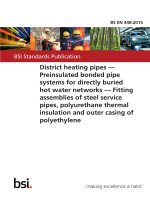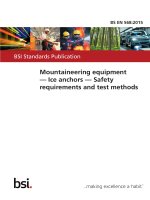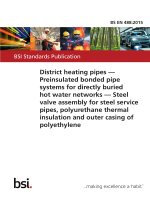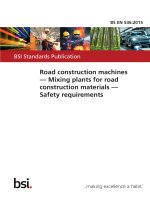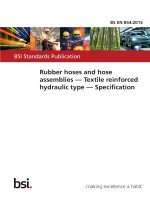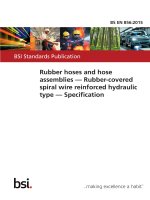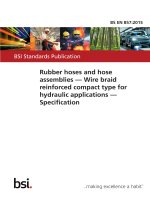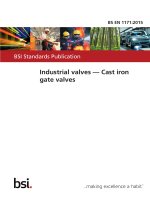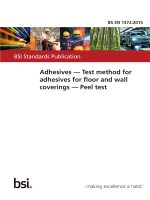BS EN 1243 : 2015 Gully tops and manhole tops for vehicular and pedestrian areas Part 3: Gully tops and manhole tops made of steel or aluminium alloys
Bạn đang xem bản rút gọn của tài liệu. Xem và tải ngay bản đầy đủ của tài liệu tại đây (1.18 MB, 40 trang )
BS EN 124-3:2015
BSI Standards Publication
Gully tops and manhole tops
for vehicular and pedestrian
areas
Part 3: Gully tops and manhole tops made
of steel or aluminium alloys
BS EN 124-3:2015
BRITISH STANDARD
National foreword
This British Standard is the UK implementation of EN 124-3:2015.
Together with BS EN 124-1:2015, BS EN 124-2:2015, BS EN 124-4:2015,
BS EN 124-5:2015 and BS EN 124-6:2015, it supersedes BS EN 124:1994
which is withdrawn.
BSI, as a member of CEN, is obliged to publish EN 124-3 as a British
Standard. However, attention is drawn to the fact that during the
development of this European Standard, the UK committee voted
against its approval as a European Standard.
The reasoning behind the response relates to the application of the
Construction Products Regulations in respect to subclause 7.3.2.6, as a
result of the AVCP Level 1 requirement.
The UK participation in its preparation was entrusted to Technical
Committee B/505, Wastewater engineering, to Subcommittee B/505/4,
“Manhole Covers, Surface Boxes And Other Road Fittings”.
A list of organizations represented on this subcommittee can be
obtained on request to its secretary.
This publication does not purport to include all the necessary provisions
of a contract. Users are responsible for its correct application.
© The British Standards Institution 2015.
Published by BSI Standards Limited 2015
ISBN 978 0 580 79319 6
ICS 93.080.30
Compliance with a British Standard cannot confer immunity from
legal obligations.
This British Standard was published under the authority of the Standards
Policy and Strategy Committee on 31 July 2015.
Amendments/corrigenda issued since publication
Date
Text affected
EN 124-3
EUROPEAN STANDARD
NORME EUROPÉENNE
EUROPÄISCHE NORM
June 2015
ICS 93.080.30
Supersedes EN 124:1994
English Version
Gully tops and manhole tops for vehicular and pedestrian areas Part 3: Gully tops and manhole tops made of steel or aluminium
alloys
Dispositifs de couronnement et de fermeture pour les zones
de circulation utilisées par les piétons et les véhicules Partie 3: Dispositifs de couronnement et de fermeture en
acier ou alliage d'aluminium
Aufsätze und Abdeckungen für Verkehrsflächen - Teil 3:
Aufsätze und Abdeckungen aus Stahl oder
Aluminiumlegierungen
This European Standard was approved by CEN on 12 March 2015.
CEN members are bound to comply with the CEN/CENELEC Internal Regulations which stipulate the conditions for giving this European
Standard the status of a national standard without any alteration. Up-to-date lists and bibliographical references concerning such national
standards may be obtained on application to the CEN-CENELEC Management Centre or to any CEN member.
This European Standard exists in three official versions (English, French, German). A version in any other language made by translation
under the responsibility of a CEN member into its own language and notified to the CEN-CENELEC Management Centre has the same
status as the official versions.
CEN members are the national standards bodies of Austria, Belgium, Bulgaria, Croatia, Cyprus, Czech Republic, Denmark, Estonia,
Finland, Former Yugoslav Republic of Macedonia, France, Germany, Greece, Hungary, Iceland, Ireland, Italy, Latvia, Lithuania,
Luxembourg, Malta, Netherlands, Norway, Poland, Portugal, Romania, Slovakia, Slovenia, Spain, Sweden, Switzerland, Turkey and United
Kingdom.
EUROPEAN COMMITTEE FOR STANDARDIZATION
COMITÉ EUROPÉEN DE NORMALISATION
EUROPÄISCHES KOMITEE FÜR NORMUNG
CEN-CENELEC Management Centre: Avenue Marnix 17, B-1000 Brussels
© 2015 CEN
All rights of exploitation in any form and by any means reserved
worldwide for CEN national Members.
Ref. No. EN 124-3:2015 E
BS EN 124-3:2015
EN 124-3:2015 (E)
Contents
Page
Foreword ..............................................................................................................................................................4
1
Scope ......................................................................................................................................................5
2
Normative references ............................................................................................................................5
3
Terms and definitions ...........................................................................................................................6
4
4.1
4.2
4.2.1
4.2.2
4.3
4.4
4.5
Materials .................................................................................................................................................6
General ....................................................................................................................................................6
Steel ........................................................................................................................................................7
General ....................................................................................................................................................7
Hot dip galvanizing ................................................................................................................................7
Stainless steel ........................................................................................................................................7
Aluminium alloy .....................................................................................................................................8
Cover fillings ..........................................................................................................................................8
5
5.1
5.2
5.3
5.4.1
5.4.2
Requirements .........................................................................................................................................8
Design and performance requirements ...............................................................................................8
Covers with fillings ............................................................................................................................. 10
Material-specific characteristics for gully tops and manhole tops made of mild steel or
aluminium alloys ................................................................................................................................. 10
Reaction to fire .................................................................................................................................... 10
Durability ............................................................................................................................................. 11
Dangerous substances ...................................................................................................................... 11
Additional requirements for gully tops and manhole tops made of steel or aluminium
alloys .................................................................................................................................................... 11
Fabrication ........................................................................................................................................... 11
Deflection under load ......................................................................................................................... 12
6
6.1
6.2
Testing ................................................................................................................................................. 12
General ................................................................................................................................................. 12
Testing of deflection under load ....................................................................................................... 12
7
7.1
7.2
7.2.1
7.2.2
7.2.3
7.2.4
7.3
7.3.1
7.3.2
7.3.3
7.3.4
7.3.5
7.3.6
7.3.7
Assessment and verification of constancy of performance - AVCP ............................................. 12
General ................................................................................................................................................. 12
Type testing ......................................................................................................................................... 12
General ................................................................................................................................................. 12
Test samples, testing and compliance criteria ................................................................................ 13
Test reports ......................................................................................................................................... 15
Shared other party results ................................................................................................................. 15
Factory production control (FPC) ..................................................................................................... 16
General ................................................................................................................................................. 16
Requirements ...................................................................................................................................... 16
Product specific requirements .......................................................................................................... 21
Initial inspection of factory and of FPC ............................................................................................ 21
Continuous surveillance of FPC ....................................................................................................... 22
Procedure for modifications .............................................................................................................. 22
One-off products and products produced in very low quantity .................................................... 22
8
Designation ......................................................................................................................................... 23
9
Marking ................................................................................................................................................ 25
5.3.1
5.3.2
5.3.3
5.4
Annex A (normative) Test of deflection under load ...................................................................................... 26
A.1
2
Test samples ....................................................................................................................................... 26
BS EN 124-3:2015
EN 124-3:2015 (E)
A.2
Deflection test load, FD ....................................................................................................................... 26
A.3
Apparatus ............................................................................................................................................. 26
A.4
Procedure ............................................................................................................................................. 26
A.5
Observations and reporting ............................................................................................................... 27
Annex ZA (informative) Clauses of this European Standard addressing the provisions of the EU
Construction Products Regulation .................................................................................................... 28
ZA.1
Scope and relevant characteristics ................................................................................................... 28
ZA.2
Procedures for AVCP of gully tops and manhole tops made of steel or aluminium alloys ........ 30
ZA.3
CE marking and labelling.................................................................................................................... 34
Bibliography ...................................................................................................................................................... 36
3
BS EN 124-3:2015
EN 124-3:2015 (E)
Foreword
This document (EN 124-3:2015) has been prepared by Technical Committee CEN/TC 165 “Wastewater
engineering”, the secretariat of which is held by DIN.
This European Standard shall be given the status of a national standard, either by publication of an identical
text or by endorsement, at the latest by December 2015 and conflicting national standards shall be withdrawn
at the latest by March 2017.
Attention is drawn to the possibility that some of the elements of this document may be the subject of patent
rights. CEN [and/or CENELEC] shall not be held responsible for identifying any or all such patent rights.
Together with EN 124-1:2015, EN 124-2:2015, EN 124-4:2015, EN 124-5:2015 and EN 124-6:2015, this
document will supersede EN 124:1994.
This document has been prepared under a mandate given to CEN by the European Commission and the
European Free Trade Association, and supports essential requirements of the Regulation (EU) No. 305/2011.
For relationship with EU Regulation(s), see informative Annex ZA, which is an integral part of this document.
EN 124, Gully tops and manhole tops for vehicular and pedestrian areas, consists of the following parts:
—
Part 1: Definitions, classification, general principles of design, performance requirements and test
methods;
—
Part 2: Gully tops and manhole tops made of cast iron;
—
Part 3: Gully tops and manhole tops made of steel or aluminium alloys;
—
Part 4: Gully tops and manhole tops made of steel reinforced concrete;
—
Part 5: Gully tops and manhole tops made of composite materials;
—
Part 6: Gully tops and manhole tops made of polypropylene (PP), polyethylene (PE) or unplasticized
poly(vinyl chloride) (PVC-U).
According to the CEN-CENELEC Internal Regulations, the national standards organizations of the following
countries are bound to implement this European Standard: Austria, Belgium, Bulgaria, Croatia, Cyprus, Czech
Republic, Denmark, Estonia, Finland, Former Yugoslav Republic of Macedonia, France, Germany, Greece,
Hungary, Iceland, Ireland, Italy, Latvia, Lithuania, Luxembourg, Malta, Netherlands, Norway, Poland, Portugal,
Romania, Slovakia, Slovenia, Spain, Sweden, Switzerland, Turkey and the United Kingdom.
4
BS EN 124-3:2015
EN 124-3:2015 (E)
1
Scope
This European Standard is applicable to gully tops and manhole tops made of mild steel, stainless steel and
aluminium alloys whether in combination with concrete or not, with a clear opening up to and including
1 000 mm for covering gullies, manholes and inspection chambers for installation in areas subjected to
pedestrian and/or vehicular traffic.
It is applicable to manhole tops and gully tops for use in
—
areas which can only be used by pedestrians and pedal cyclists (at least class A 15),
—
pedestrian areas and comparable areas, car parks or car parking decks (at least class B 125),
—
the area of kerbside channels of roads which, when measured from the kerb edge, extends a maximum
of 0,5 m into the carriageway and a maximum of 0,2 m into the pedestrian area (at least class C 250),
—
carriageways of roads (including pedestrian streets), hard shoulders and parking areas, for all types of
road vehicles (at least class D 400),
—
areas imposing high wheel loads, e.g. docks, aircraft pavements (at least class E 600),
—
areas imposing particularly high wheel loads, e.g. aircraft pavements (class F 900).
This European Standard is not applicable in isolation but only in combination with EN 124-1 and gives
guidance for combinations of covers/gratings made of steel or aluminium alloys with frames according to
EN 124-2 and EN 124-4, EN 124-5 or EN 124-6.
Fabrication of manhole tops and gully tops in accordance with this standard is limited to cold forming,
mechanical crimping or welding together component parts made of metal plate, strip or bar or rolled or
extruded metal sections.
This European Standard is not applicable to:
—
manhole tops and gully tops made of aluminium tread plates for use in carriageways of roads (class
D 400) and areas imposing high wheel loads (Classes E 600 and F 900);
—
concave gratings for class D 400 installed in carriageways of roads or hard shoulders and concave
gratings for classes F 900 and E 600;
—
gratings/covers as part of prefabricated drainage channels according to EN 1433;
—
floor and roof gullies in buildings which are specified in EN 1253 (all parts); and
—
surface boxes.
2
Normative references
The following documents, in whole or in part, are normatively referenced in this document and are
indispensable for its application. For dated references, only the edition cited applies. For undated references,
the latest edition of the referenced document (including any amendments) applies.
EN 124-1:2015, Gully tops and manhole tops for vehicular and pedestrian areas — Part 1: Definitions,
classification, general principles of design, performance requirements and test methods
EN 124-2:2015, Gully tops and manhole tops for vehicular and pedestrian areas — Part 2: Gully tops and
manhole tops made of cast iron
5
BS EN 124-3:2015
EN 124-3:2015 (E)
EN 124-4:2015, Gully tops and manhole tops for vehicular and pedestrian areas — Part 4: Gully tops and
manhole tops made of steel reinforced concrete
EN 124-5:2015, Gully tops and manhole tops for vehicular and pedestrian areas — Part 5: Gully tops and
manhole tops made of composite materials
EN 124-6:2015, Gully tops and manhole tops for vehicular and pedestrian areas — Part 6: Gully tops and
manhole tops made of polypropylene (PP), polyethylene (PE) or unplasticized poly(vinyl chloride) (PVC-U)
EN 206:2013, Concrete — Specification, performance, production and conformity
EN 573-3, Aluminium and aluminium alloys — Chemical composition and form of wrought products — Part 3:
Chemical composition and form of products
EN 1386, Aluminium and aluminium alloys — Tread plate — Specifications
EN 1676:2010, Aluminium and aluminium alloys — Alloyed ingots for remelting — Specifications
EN 1706, Aluminium and aluminium alloys — Castings — Chemical composition and mechanical properties
EN 10025-1, Hot rolled products of structural steels — Part 1: General technical delivery conditions
EN 10088-1:2014, Stainless steels — Part 1: List of stainless steels
EN 10130, Cold rolled low carbon steel flat products for cold forming — Technical delivery conditions
EN ISO 1461, Hot dip galvanized coatings on fabricated iron and steel articles — Specifications and test
methods (ISO 1461)
EN ISO 3452-1, Non-destructive testing - Penetrant testing — Part 1: General principles (ISO 3452-1)
EN ISO 9606-1, Qualification testing of welders — Fusion welding — Part 1: Steels (ISO 9606-1)
EN ISO 9606-2, Qualification test of welders — Fusion welding — Part 2: Aluminium and aluminium alloys
(ISO 9606-2)
EN ISO 14554 (all parts), Quality requirements for welding — Resistance welding of metallic materials
(ISO 14554)
EN ISO 14732, Welding personnel — Qualification testing of welding operators and weld setters for
mechanized and automatic welding of metallic materials (ISO 14732)
EN ISO 15609 (all parts), Specification and qualification of welding procedures for metallic materials —
Welding procedure specification (ISO 15609)
3
Terms and definitions
For the purposes of this document, the terms and definitions given in EN 124-1:2015 apply.
4
4.1
Materials
General
Manhole tops, gully tops and gratings complying with this standard shall be manufactured from the following
materials:
6
BS EN 124-3:2015
EN 124-3:2015 (E)
a)
steel according to 4.2;
b)
stainless steel according to 4.3;
c)
aluminium alloys according to 4.4.
The minimum thickness of sheet material prior to corrosion protection shall be at least 2,75 mm for C 250
covers and above.
Any element made of the materials specified in 4.1 a) to c) can be used in combination with elements of
materials specified in EN 124-2, EN 124-4, EN 124-5 or EN 124-6. In such cases the manhole tops or gully
tops shall comply with the relevant design and performance and testing requirements as listed in Table 1.
In addition elements shall comply with the requirements for the material related EN 124-2, EN 124-4,
EN 124-5 or EN 124-6 as applicable. Each element shall be marked accordingly. The load class to be
declared for the combined product shall be restricted to the lower class determined for any constituent
element according to the relevant part of EN 124 series.
EXAMPLE
Where a cover is made of steel, class C 250, and the frame is made of PVC-U, class B 125, the manhole
top or gully top is marked with EN 124-3 and the class to be declared for the combined product is the class of the frame
according to EN 124-6.
4.2
Steel
4.2.1
General
Steel manhole tops and gully tops shall be made from steel according to EN 10130 or EN 10025-1 and shall
be resistant to corrosion. For use in normal conditions corrosion resistance can be ensured, e.g. by hot-dip
galvanizing on a clean surface in accordance with 4.2.2. Prior to application of any surface corrosion
protection system, manhole tops and gully tops shall be fettled.
4.2.2
Hot dip galvanizing
Where corrosion resistance is achieved by hot dip galvanizing it shall be in accordance with EN ISO 1461.
There shall be no sharp edges resulting from hot dip galvanizing.
After a manhole top or gully top has been hot dip galvanized it can be straightened to overcome any distortion
prior to fitting the manhole cover or gully grating in its frame. Any such straightening shall not adversely affect
the integrity of the hot dip galvanizing or the structure of the manhole top or the gully top.
NOTE 1
Hot dip galvanization is regarded as corrosion protection system and not regarded as an aesthetic coating.
NOTE 2
Other supplementary coatings can be applied to the hot dip galvanized surface, e.g. coating or paint systems.
4.3
Stainless steel
Stainless steel manhole tops and gully tops for use in normal conditions (see EN 124-1:2015, 5.1) shall be
fabricated from austenitic stainless steel grades 1.4301, 1.4306, 1.4307, 1.4401, 1.4404, 1.4432 or 1.4571 in
accordance with EN 10088-1:2014. For normal conditions of use no surface corrosion protection system shall
be required. Appropriate post fabrication finishing processes are required to avoid iron contamination, e.g.
welded joints shall be treated by pickle passivation process or shot blasting.
Corrosion protection or another grade of stainless steel should be required if the manhole top or gully top is
subject to more severe conditions of use, e.g. in a particularly aggressive chemical environment.
Stainless steel manhole tops and gully tops can be supplied with aesthetic surface finishes, e.g. varnish or
paint or cleaning or bead blasting.
7
BS EN 124-3:2015
EN 124-3:2015 (E)
4.4
Aluminium alloys
Aluminium manhole tops and gully tops shall be fabricated or cast from aluminium alloys according to
EN 1706, EN 1676 or EN 573-3 for use under “cyclic wet and dry” conditions and a slightly aggressive
chemical environment as specified in EN 124-1:2015, 5.1. Alloys having a declared copper content of less
than 0,1 % shall not require additional corrosion protection. Corrosion protection can also be achieved by
anodizing according to EN ISO 7599, Class AA 25. Corrosion protection systems other than anodizing or
choice of alloys with specific corrosion resistance shall give corrosion protection equivalent to that of
anodizing. Corrosion protection or another grade of aluminium may be required if the manhole top or gully top
is subject to more severe conditions of use as given in EN 124-1:2015, 5.1, e.g. in a particularly aggressive
chemical environment.
Aluminium tread plates shall be in accordance with EN 1386. Their use for manhole tops and gully tops is
restricted to classes A 15 to C 250.
4.5
Cover fillings
In the case of covers placed on the market in filled condition the filling shall consist of either:
a)
concrete with a minimum compressive strength class of C35/45 according to EN 206:2013, at least
suitable for use in “cyclic wet and dry” conditions, or
b)
other material complying with the intended use/place of installation expectations and with appropriate
relevant European Standards at least suitable for use in “cyclic wet and dry” conditions.
In the case of covers placed on the market in unfilled condition and the filling is applied subsequently, the
filling materials shall have a minimum performance comparable to concrete or the surrounding pavement
materials and shall fulfil the requirements of the appropriate European Standards.
5
5.1
Requirements
Design and performance requirements
Manhole tops, gully tops and gratings made of materials according to 4.1 shall meet the design and
performance and testing requirements in accordance with EN 124-1 as listed in Table 1.
8
BS EN 124-3:2015
EN 124-3:2015 (E)
Table 1 — Design, performance and testing requirements in accordance with EN 124-1 for gully tops
and manhole tops made of mild steel, stainless steel or aluminium alloys
Characteristic
Requirements
acc. to
EN 124-1:
2015 Clause
Testing
acc. to
EN 124-1:
2015 Clause
Relevant for class
A 15
B 125 C 250 D 400 E 600 F 900
Related to the design
Vents in covers
6.1
8.4.1
x
x
x
x
x
x
Clear opening of manhole
tops for man entry
6.2
8.4.2
x
x
x
x
x
x
Depth of insertion
6.3
8.4.3
–
–
–
x
x
x
Clearance
6.4
8.4.4
x
x
x
x
x
x
Compatibility of seatings
6.5
8.4.5
–
–
–
x
x
x
6.7
8.4.7
x
x
x
x
x
x
Slot dimensions of gratings
6.8
8.4.8
x
x
x
x
x
x
Dirt pans and dirt buckets
6.9
8.4.9
x
x
x
x
x
x
Positioning of covers and
gratings
6.10
8.4.10
x
x
x
x
x
x
Flatness of manhole covers
and gratings
6.11
8.4.11
–
–
–
x
x
x
Concaveness of gratings
6.12
8.4.12
x
x
x
x
x
x
Surface conditions
6.13
8.4.13
x
x
x
x
x
x
Manhole tops with sealing
features
6.14
Visual
inspection of
presence of
anchors
x
x
x
x
x
x
Frame bearing area
6.15
8.4.14
x
x
x
x
x
x
Frame depth
6.16
8.4.15
–
–
–
x
x
x
Opening angle of hinged
covers/gratings
6.17
8.4.16
x
x
x
x
x
x
Appearance
7.1
Visual
inspection
x
x
x
x
x
x
Load bearing capacity
7.2
8.3
x
x
x
x
x
x
Permanent set
7.3
8.2
x
x
x
x
x
x
Securing of the cover/grating
within the frame
6.6
8.4.6
x
x
x
x
x
x
Skid resistance
7.4
8.4.13
x
x
x
x
x
x
Child safety
7.5
8.5
x
x
x
x
x
x
Handling
gratings
of
covers
and
Related to the performance
x
To be applied.
9
BS EN 124-3:2015
EN 124-3:2015 (E)
5.2
Covers with fillings
When tested in accordance with EN 124-1:2015, Clause 8, covers placed on the market filled with concrete or
other filling materials and covers designed to be filled and placed on the market unfilled shall comply with
requirements of Clause 4 and Clause 5.
Covers of classes A 15 and B 125, designed to be filled, placed on the market unfilled and which are capable
of meeting the declared load class only in filled condition, can be filled subsequently on site with concrete in
accordance with 4.5. Those covers shall comply with the requirements of Clause 4 and Clause 5 in the
condition filled with concrete.
They shall be tested after being filled in accordance with the manufacturer’s instructions for filling. The
manufacturer’s instructions for filling shall be supplied with the product and shall include all information for the
filling procedure including the grade of the material used to ensure the declared performance after filling.
Filling materials used after the manhole top or gully top with an unfilled cover has been placed on the market,
are subject to selection by the specifier or client. Their performance in service and their durability should be
controlled to comply with the intended use/place of installation expectations, and with appropriate relevant
European Standards. If freeze-thaw resistance is required, covers filled with concrete shall meet the freezethaw requirements in accordance with EN 124-4.
5.3 Material-specific characteristics for gully tops and manhole tops made of mild steel or
aluminium alloys
5.3.1
Reaction to fire
Where use of manhole tops and gully tops in accordance with this standard is subject to national regulatory
requirements on reaction to fire, their reaction to fire performance shall be declared. Manhole tops and gully
tops made of steel or aluminium alloys are classified as Class A1 without the need for testing (CWT), in
1)
accordance with the relevant Commission Decision .
NOTE 1
Steel or aluminium alloys, as homogeneously distributed materials for these products (whether in combination
with concrete or not), are considered as material of known and stable performance with respect to the reaction to fire
performance as it does not consist of any organic material and consequently does not contribute to fire. Under these
conditions it can be considered as Class A1 material.
NOTE 2
The class of reaction to fire performance of manhole tops and gully tops made of steel or aluminium alloys is
regarded as the class for the constituent material (e.g. steel or aluminium).
Conversely, where the use of manhole tops and gully tops is not subject to national regulatory requirements
on reaction to fire, either the Class A1 (see above) or “No Performance Determined” (NPD) may be declared.
NOTE 3
Where the compatibility of seatings is achieved by the use of cushioning inserts, only a negligible area of the
cushioning insert material would be exposed to fire, considering the end use situation. There is no relevance in relation to
the reaction to fire performance and embedded cushioning inserts would not be able to ignite or to propagate fire there.
Their contribution to fire spread is not of concern, nor is an influence expected on the fire behaviour of the neighbouring
material and the contribution to fire propagation is negligible. Considering these aspects, separate testing and
classification of cushioning inserts is not necessary.
1) See Decision of the Commission 96/603/EC of 1996-10-04 (see OJEU L 267 of 1996-10-19), as amended twice by
2000/605/EC of 2000-09-26 (see OJEU L 258 of 2000-10-12) and by 2003/424/EC of 2003-06-06 (see OJEU L 144 of
2003-06-12).
10
BS EN 124-3:2015
EN 124-3:2015 (E)
5.3.2
5.3.2.1
Durability
General
The materials specified in Clause 4 including their corrosion protection requirements are materials of known
and stable performance with respect to their application within the scope of this standard. No further material
tests are required for material durability.
The durability of manhole tops and gully tops manufactured from steel, stainless steel or aluminium alloys will
depend upon design features and exposure conditions (see EN 124-1:2015, 5.1). The prescribed framework
of requirements and test methods for the mandated performance characteristics according to Clause 5 will
also reflect the durability of manhole tops and gully tops.
5.3.2.2
Durability of load bearing capacity
Durability of load bearing capacity is ensured by meeting the requirements of EN 124-1:2015, 7.2 and 7.3, the
proportion between test load and maximum load to be expected in service and in conjunction with the stable
behaviour of the material specified in Clause 4 covers all relevant effects which may influence the durability of
the load bearing capacity.
5.3.2.3
Durability of securing of covers/gratings within the frame
Durability of securing of covers/gratings in the frame against unintended lifting is ensured by using materials
with proven resistance against corrosion and passing the test according to EN 124-1:2015, 8.4.6.
5.3.2.4
Durability of skid resistance
Durability of skid resistance is ensured by meeting the requirements of EN 124-1:2015, 7.4, in conjunction
with the stable resistance of the material itself against loss of grip under normal conditions of use.
5.3.2.5
Durability of effectiveness of child safety characteristics
Durability of the child safety characteristics concerning the resistance of manhole tops and gully tops against
the removal by children is ensured by re-inspecting the weight or the locking accessory or the securing
feature, as appropriate, is still functional after testing the securing in accordance with EN 124-1:2015, 8.4.6.
5.3.3
Dangerous substances
National regulations on dangerous substances may require verification and declaration on release, and
sometimes content, when construction products covered by this standard are placed on those markets. In the
absence of European harmonized test methods, verification and declaration on release/content should be
done taking into account national provisions in the place of use.
5.4 Additional requirements for gully tops and manhole tops made of steel or aluminium
alloys
5.4.1
Fabrication
Welds shall be visually inspected for integrity. The specification and qualification of welding procedures for
covers shall conform to relevant part of EN ISO 15609 series. Fabrication of fusion welded component parts
of a fabricated manhole top shall be undertaken by a welder approved by the procedures in EN ISO 9606-1
for steel and EN ISO 9606-2 for aluminium alloys.
Fabrication of resistance welded metallic components shall conform to the quality requirements of
EN ISO 14554 (all parts). Approval testing of welding operators for fusion welding and resistance weld setters
for fully mechanised and automatic welding of metallic materials shall conform to EN ISO 14732. During
approval testing welds shall be evaluated according to EN ISO 3452-1.
11
BS EN 124-3:2015
EN 124-3:2015 (E)
5.4.2
Deflection under load
The maximum deflection under load shall be ≤ CO/360 for covers to be filled with brittle materials other than
concrete. For covers to be filled with concrete, the maximum deflection under load shall be ≤ CO/250. For all
other covers according to this standard, the maximum deflection under load shall be declared as mm per mm
of clear opening.
6
Testing
6.1
General
Gully tops and manhole tops according to this standard shall be tested as complete units in their intended
position of use where the cover/grating is suitably positioned within the frame in accordance with
EN 124-1:2015, Clause 8, as listed in Table 1, and in addition in accordance with 6.2.
Gully tops and manhole tops consisting of covers with fillings or covers designed to be filled subsequently,
shall be tested as follows:
1)
Covers placed on the market filled with concrete or other filling materials shall be tested in filled condition.
2)
Covers placed on the market unfilled shall be tested without filling.
3)
Covers for the field of application of classes A 15 to B 125 placed on the market unfilled and filled
subsequently in accordance with the manufacturer’s instructions shall be tested with concrete in
accordance with the manufacturer’s instructions for filling.
All tested products shall be visually inspected without magnification.
6.2
Testing of deflection under load
Deflection under load shall be tested in accordance with Annex A by applying a test load FD = 1/3 FT.
7
Assessment and verification of constancy of performance - AVCP
7.1
General
The compliance of gully tops and manhole tops with the requirements of this standard and with the
performances declared by the manufacturer in the DoP shall be demonstrated by:
—
determination of the product type on the basis of type testing;
—
factory production control by the manufacturer, including product assessment.
The manufacturer shall always retain the overall control and shall have the necessary means to take
responsibility for the conformity of the product with its declared performance(s).
7.2
7.2.1
Type testing
General
All performances related to characteristics included in this standard shall be determined when the
manufacturer intends to declare the respective performances unless the standard gives provisions for
declaring them without performing tests (e.g. use of previously existing data, classified without further testing
(CWFT) and conventionally accepted performance).
Assessment previously performed in accordance with the provisions of this standard, may be taken into
account provided that they were made to the same or a more rigorous test method, under the same AVCP
12
BS EN 124-3:2015
EN 124-3:2015 (E)
system on the same product or products of similar design, construction and functionality, such that the results
are applicable to the product in question.
NOTE 1
Same AVCP system means testing by an independent third party, when relevant, under the responsibility of a
notified product certification body, when relevant.
For the purposes of assessment, the manufacturer's products may be grouped into families, where it is
considered that the results for one or more characteristics from any one product within the family are
representative for the same characteristics for all products within that same family.
NOTE 2
Products can be grouped in different families for different characteristics.
Reference to the assessment method standards should be made to allow the selection of a suitable
representative sample.
In addition, the determination of the product type shall be performed for all characteristics included in the
standard for which the manufacturer declares the performance:
—
at the beginning of the production of a new or modified gully top and manhole top (unless a member of
the same product range), or
—
at the beginning of a new or modified method of production (where this can affect the stated properties),
or
—
they shall be repeated for the appropriate characteristic(s), whenever a change occurs in the gully top or
manhole top design, in the raw material or in the supplier of the components, or in the method of
production (subject to the definition of a family), which would affect significantly one or more of the
characteristics.
Where components are used whose characteristics have already been determined, by the component
manufacturer, on the basis of assessment methods of other product standards, these characteristics need not
be re-assessed. The specifications of these components shall be documented.
Products bearing regulatory marking in accordance with appropriate harmonized European specifications may
be presumed to have the performances declared in the DoP, although this does not replace the responsibility
on the manhole tops and gully tops manufacturer to ensure that the manhole tops and gully tops as a whole
are correctly manufactured and its component products have the declared performance values.
7.2.2
Test samples, testing and compliance criteria
The number of samples of gully tops and manhole tops to be tested/assessed shall be in accordance with
Table 2. Characteristics for which the performance is to be declared are written in bold letters.
Table 2 — Number of samples to be tested and compliance criteria
Characteristic
Requirement
Assessment method
No. of
a
samples
Compliance criteria
for the declared performance:
Reaction to fire
5.3.1
Classified without testing
(CWT)
3
EN 124–3:2015, 5.3.1, Class A1
Frame bearing area
5.1
EN 124–1:2015, 8.4.14
3
EN 124–1:2015, 6.15, calculated
2
value Pb ≤ 7,5 N/mm
Load bearing capacity
5.1
EN 124–1:2015, 8.3
3
EN 124–1:2015, 7.2, test load for
the declared class
13
BS EN 124-3:2015
EN 124-3:2015 (E)
Characteristic
Permanent set
Requirement
5.1
Assessment method
EN 124–1:2015, 8.2
No. of
a
samples
Compliance criteria
3
EN 124–1:2015, 7.3, permissible
value for the declared class
Securing of the cover/
grating within the
frame
5.1
EN 124–1:2015, 8.4.6
3
EN 124–1:2015, 6.6, declared
method and either weight in kg or
value Fv in kN and appropriate h in
mm, as applicable
Child safety
5.1
EN 124–1:2015, 8.5
3
EN 124–1:2015, 7.5, declared
method or weight
EN 124–1:2015, 8.4.13
a)
3
EN 124–1:2015, 7.4.2 a), declared
as “concrete surface” for the
material used
EN 124–1:2015, 8.4.13
b)
3
EN 124–1:2015, 7.4.2 b), declared
as “raised pattern” for the specified
raised pattern
— other surface
EN 124–1:2015, 8.4.13
c)
3
EN 124–1:2015, 7.4.2 c), for the
calculated and declared value of
USRV
b) Gratings
EN 124–1:2015, 8.4.13
b)
3
EN 124–1:2015, 7.4.3, declared as
“raised pattern” for the specified
raised pattern or “slots” the
measured slot dimensions
Skid resistance of
a) Covers with
— concrete surface
— raised pattern
5.1
5.1
c) Frames with max.
horizontal visible width
of
— ≤ 40 mm or
— > 40 mm
5.1
EN 124–1:2015, 7.4.4
3
EN 124–1:2015, 7.4.2, determined
acc. to the requirement clause and
expressed as
—
—
“NPD” for ≤ 40 mm or
method or value for > 40 mm
Durability of
—
load
bearing
b
capacity against
mechanical failure
EN 124–3:2015, 4.1,
EN 124–1: 2015, 7.2 and 7.3
5.3.2
EN 124–1:2015, 8.2
EN 124–1:2015, 8.3
3
5.3.2
EN 124–1:2015, 8.4.6
3
EN 124–1:2015, 6.6, declared as
“Pass” according to the material
used and the test method applied
c
declared as “Pass” according to the
material used and the test method
applied
—
securing against
unintended lifting
—
skid resistance
against loss of grip
5.3.2
EN 124–1:2015, 8.4.13
3
EN 124–1:2015, 7.4 declared as
“Pass” for the declared value of
USRV and for the declared method
and the material used
—
effectiveness of
child
safety
characteristics
5.3.2
EN 124–1:2015, 8.4.6
3
EN 124–1:2015, 6.6, declared as
“Pass” according to the material
used and the method declared
Vents in covers
5.1
EN 124–1:2015, 8.4.1
3
EN 124–1:2015, 6.1
Clear
opening
of
manhole tops for man
5.1
EN 124–1:2015, 8.4.2
3
EN 124–1:2015, 6.2
for the design:
14
BS EN 124-3:2015
EN 124-3:2015 (E)
Characteristic
Requirement
No. of
a
samples
Assessment method
Compliance criteria
entry
Depth of insertion
5.1
EN 124–1:2015, 8.4.3
3
EN 124–1:2015, 6.3
Clearance
5.1
EN 124–1:2015, 8.4.4
3
EN 124–1:2015, 6.4
5.1
EN 124–1:2015, 8.4.5
3
EN 124–1:2015, 6.5
Handling of covers and
gratings
5.1
EN 124–1:2015, 8.4.7
3
EN 124–1:2015, 6.7
Slot
dimensions
gratings
5.1
EN 124–1:2015, 8.4.8
3
EN 124–1:2015, 6.8
5.1
EN 124–1:2015, 8.4.9
3
EN 124–1:2015, 6.9
Positioning of covers
and gratings
5.1
EN 124–1:2015, 8.4.10
3
EN 124–1:2015, 6.10
Flatness of manhole
covers and gratings
5.1
EN 124–1:2015, 8.4.11
3
EN 124–1:2015, 6.11
Concaveness
gratings
5.1
EN 124–1:2015, 8.4.12
3
EN 124–1:2015, 6.12
5.1
EN 124–1:2015, 8.4.13
3
EN 124–1:2015, 6.13
5.1
Visual
inspection
presence of anchors
3
EN 124–1:2015, 6.14
Frame depth
5.1
EN 124–1:2015, 8.4.15
3
EN 124–1:2015, 6.16
Opening
angle
of
hinged covers/gratings
5.1
EN 124–1:2015, 8.4.16
3
EN 124–1:2015, 6.17
Appearance
5.1
Visual inspection
3
EN 124–1:2015, 7.1
EN 124–3:2015, 6.2
3
EN 124–3:2015, 5.4.2
Compatibility
seatings
Dirt pans
buckets
of
and
of
dirt
of
Surface conditions
Manhole
tops
sealing feature
with
Deflection under load
5.4.2
of
a
If one of the 3 samples fails, the specific test can be repeated with 5 new samples. All the 5 samples shall pass the test.
The proportion between the test load for the declared class and the maximum load to be expected in service in conjunction
with the stable behaviour of the material specified in Clause 4 covers all effects which can influence the durability of the load
bearing capacity.
b
c
Ensured by using materials with proven resistance against corrosion and passing the test according to EN 124–1, 8.4.6.
7.2.3
Test reports
The results of the determination of the product type shall be documented in test reports. Test reports shall be
retained by the manufacturer for at least 10 years after the last date of production of the gully top or manhole
top to which they relate.
7.2.4
Shared other party results
A manufacturer may use the results of the product type determination obtained by someone else (e.g. by
another manufacturer, as a common service to manufacturers, or by a product developer), to justify his own
declaration of performance regarding a product that is manufactured according to the same design (e.g.
dimensions) and with raw materials, constituents and manufacturing methods of the same kind, provided that:
—
the results are known to be valid for products with the same essential characteristics relevant for the
product performance;
15
BS EN 124-3:2015
EN 124-3:2015 (E)
—
in addition to any information essential for confirming that the product has such same performances
related to specific essential characteristics, the other party who has carried out the determination of the
product type concerned or has had it carried out, has expressly accepted to transmit to the manufacturer
the results and the test report to be used for the latter’s product type determination, as well as information
regarding production facilities and the production control process that can be taken into account for FPC;
—
the manufacturer using other party results accepts to remain responsible for the product having the
declared performances and he also:
— ensures that the product has the same characteristics relevant for performance as the one that has
been subjected to the determination of the product type, and that there are no significant differences
with regard to production facilities and the production control process compared to that used for the
product that was subjected to the determination of the product type; and
— keeps available a copy of the determination of the product type report that also contains the
information needed for verifying that the product is manufactured according to the same design and
with raw materials, constituents and manufacturing methods of the same kind.
7.3
Factory production control (FPC)
7.3.1
General
The manufacturer shall establish, document and maintain an FPC system to ensure that the products placed
on the market comply with the declared performance of the essential characteristics.
The FPC system shall consist of procedures, regular inspections and tests and/or assessments and the use of
the results to control raw and other incoming materials or components, equipment, the production process and
the product.
All the elements, requirements and provisions adopted by the manufacturer shall be documented in a
systematic manner in the form of written policies and procedures.
This factory production control system documentation shall ensure a common understanding of the evaluation
of the constancy of performance and enable the achievement of the required product performances and the
effective operation of the production control system to be checked. Factory production control therefore brings
together operational techniques and all measures allowing maintenance and control of the compliance of the
product with the declared performances of the essential characteristics.
7.3.2
7.3.2.1
Requirements
General
The manufacturer is responsible for organizing the effective implementation of the FPC system in line with the
content of this product standard. Tasks and responsibilities in the production control organization shall be
documented and this documentation shall be kept up-to-date.
The responsibility, authority and the relationship between personnel that manages, performs or verifies work
affecting product constancy, shall be defined. This applies in particular to personnel that need to initiate
actions preventing product non-constancies from occurring, actions in case of non-constancies and to identify
and register product constancy problems.
Personnel performing work affecting the constancy of performance of the product shall be competent on the
basis of appropriate education, training, skills and experience for which records shall be maintained.
In each factory the manufacturer may delegate the action to a person having the necessary authority to:
—
16
identify procedures to demonstrate constancy of performance of the product at appropriate stages;
BS EN 124-3:2015
EN 124-3:2015 (E)
—
identify and record any instance of non-constancy;
—
identify procedures to correct instances of non-constancy.
The manufacturer shall draw up and keep up-to-date documents defining the factory production control. The
manufacturer's documentation and procedures should be appropriate to the product and manufacturing
process. The FPC system should achieve an appropriate level of confidence in the constancy of performance
of the product. This involves:
a)
the preparation of documented procedures and instructions relating to factory production control
operations, in accordance with the requirements of the technical specification to which reference is made;
b)
the effective implementation of these procedures and instructions;
c)
the recording of these operations and their results;
d)
the use of these results to correct any deviations, repair the effects of such deviations, treat any resulting
instances of non-conformity and, if necessary, revise the FPC to rectify the cause of non-constancy of
performance.
Where subcontracting takes place, the manufacturer shall retain the overall control of the product and ensure
that he receives all the information that is necessary to fulfil his responsibilities according to this European
Standard.
If the manufacturer has part of the product designed, manufactured, assembled, packed, processed and/or
labelled by subcontracting, the FPC of the subcontractor may be taken into account, where appropriate for the
product in question.
The manufacturer who subcontracts all of his activities may in no circumstances pass the above
responsibilities on to a subcontractor.
NOTE
Manufacturers having an FPC system, which complies with EN ISO 9001 and which addresses the provisions
of the present European Standard are considered as satisfying the FPC requirements of the Regulation (EU) No.
305/2011.
7.3.2.2
7.3.2.2.1
Equipment
Testing
All weighing, measuring and testing equipment shall be calibrated and regularly inspected according to
documented procedures, frequencies and criteria.
7.3.2.2.2
Manufacturing
All equipment used in the manufacturing process shall be regularly inspected and maintained to ensure use,
wear or failure does not cause inconsistency in the manufacturing process. Inspections and maintenance shall
be carried out and recorded in accordance with the manufacturer’s written procedures and the records
retained for the period defined in the manufacturer's FPC procedures.
7.3.2.3
Raw materials and components
The specifications of all incoming raw materials and components shall be documented, as shall the
inspection-scheme for ensuring their compliance. In case supplied kit components are used, the constancy of
performance system of the component shall be that given in the appropriate harmonized technical
specification for that component.
17
BS EN 124-3:2015
EN 124-3:2015 (E)
7.3.2.4
Traceability and marking
Individual products shall be identifiable and traceable with regard to their production origin. The manufacturer
shall have written procedures ensuring that processes related to affixing traceability codes and/or markings
are inspected regularly.
7.3.2.5
Controls during manufacturing process
The manufacturer shall plan and carry out production under controlled conditions.
For components used for the assembly of manhole tops and gully tops, such as cushioning inserts, bolts, etc.
not specified in this standard and coating materials, the supplier's documentation shall be checked at every
delivery for compliance with the manufacturer's specification. The documents shall be retained for a period of
10 years.
For all materials in accordance with Clause 4, used for the manufacturing process of manhole tops and gully
tops, specified in this standard the supplier's documentation shall be checked at every delivery for compliance
with the manufacturer's specification.
NOTE
For deliveries from suppliers having an established quality management system, the frequency of inspection
can be reduced at the discretion of the manufacturer.
Raw materials used for the manufacturing process of manhole tops and gully tops made of steel or aluminium
alloys shall be inspected according to Table 3 or Table 4 as applicable.
Table 3 — Material delivery inspection for steel and stainless steel
Aspect of inspection
Method of inspection
Steel
Cert supplier
Stainless steel
Cert supplier
a
Frequency of inspection
Document
retention period
a
Every delivery
1 year
a
Every delivery
1 year
Certificate of the supplier:
— deliveries from suppliers having a certified quality insurance system shall be subject to random control;
— deliveries from suppliers having no certified quality insurance system shall be subject to a systematic control for
each delivery.
Table 4 — Material delivery inspection for aluminium alloys
Aspect of inspection
Method of
inspection
Raw material storage area
Visually
Aluminium alloys (4.4)
Cert supplier
Additives
Refer to the order
Document
retention period
Frequency of inspection
Regularly
a
b
-
Every delivery
1 year
Every delivery
1 year
Regularly/when changed
1 year
Energy for melting:
Gas
Sand for moulds/cores
a
b
18
Cert supplier
a
Cert supplier
sieve analysis
a
and
Regularly
b
1 year
Certificate of the supplier:
— deliveries from suppliers having a certified quality insurance system shall be subject to random control;
— deliveries from suppliers having no certified quality insurance system shall be subject to a systematic control for
each delivery.
FPC – Factory Production Control
